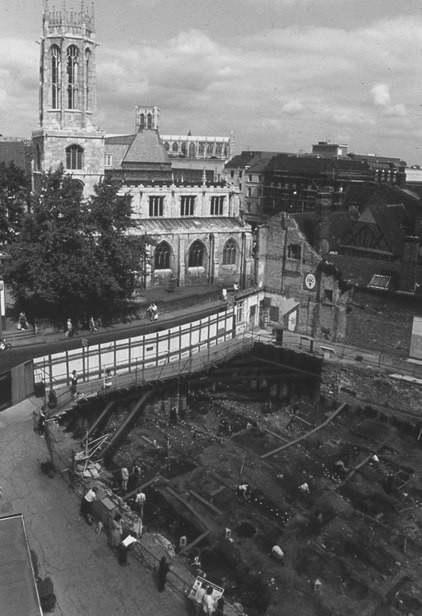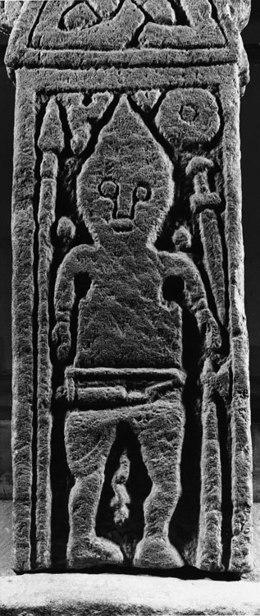The Vikings: A Very Short Introduction (11 page)
Read The Vikings: A Very Short Introduction Online
Authors: Julian D. Richards
Tags: #History, #General, #Social Science, #Archaeology, #Europe, #Medieval


Settl
ers in En
glan
d
10. Excavations in progress at Coppergate, York
throughout England rural ‘cottage’ industry was being replaced by town-based industrialized mass production in response to the new urban markets.
69
Erik Bloodaxe (d. 954)
Erik Bloodaxe, Viking leader and King of Northumbria, was
the son of Haraldr Finehair, King of Vestfold (872?–
c
.930).
Few facts about his life are reliably attested, other than that
he was expelled from York in 954, and may have been killed
on the Roman road to Cumbria at Stainmore (the modern
A66). His fame is due to his prominence in the saga literature, unique for a 10th-century Scandinavian king in the
British Isles. Erik is said to have begun his Viking career at
the age of 12, meeting his wife Gunnhild on an expedition to
the White Sea. Erik became king of Norway on the death of
his father, killing several of his brothers and rivals, before
being ousted by his younger brother Hákon. Erik next made
sg
his way to Orkney, and then to Northumbria, eventually res-kin
iding in York until his expulsion. Erik also appears in
Egils
e Vi
Saga
, as the enemy of the psychopath and poet Egil Skalla-Th
grímsson. Despite pardoning Egil’s life in return for a praise
poem, Erik was generally given a bad press, with a remarkable career of plunder and homicide. He embodies the modern perception of the Viking world.
Nonetheless, although Viking Age England was thriving, the Vikings themselves have been hard to find. The relative scarcity of identifiable burials of a Scandinavian character in England must lead to the conclusion that – unlike those on the Atlantic margins –
most settlers were not buried in their traditional dress. The exceptions are mostly clustered in the North-West and Cumbria, areas where a Scandinavian identity seems to have been maintained for longer, and where most settlers lived in scattered farmsteads and were buried on their farms. A number of individual mound burials, frequently containing weaponry, were generally excavated in the 70
19th century, at sites such as Aspatria, Hesket in the Forest, and Claughton Hall. They follow similar burial practices to those observed on the Isle of Man (p. 85). The only cemetery was discovered in 2004 by a metal-detectorist, on a low hill overlooking the village of Cumwhitton, near Carlisle. It comprised just six burials – four males and two females – buried with weaponry and jewellery. A mound had been raised over one of the males.
In lowland and eastern England such burials are extremely scarce and it appears that Scandinavian cultural identity was rarely reflected in the burial rite. Newcomers in these areas may have often joined established settlements and may have been accommodated within existing Anglo-Saxon graveyards. Another recent discovery, at Adwick-le-Street, near Doncaster, provides a clear exception. A woman had been buried with a non-matching pair of oval brooches, of late 9th-century date, and fragments of an
Settl
iron knife and key or latch-lifter. A small copper-alloy bowl,
ers in En
probably manufactured in the Celtic West, had been placed at her feet. Isotope analysis of her teeth shows she originated from the
glan
Trondheim area of Norway, or possibly north-east Scotland. There
d
is no evidence for settlement or other burials in the locality and she must represent an isolated death.
The other exceptions are provided by two remarkable cemeteries which have been associated with the over-wintering of the Great Army at Repton, in 873–4. Having taken over the Mercian royal shrine at Repton, the Viking army constructed a massive D-shaped encampment, using the River Trent to protect the flat side of the D, and the tower of the Anglo-Saxon church as a gatehouse. In Anglo-Saxon England power could be acquired through association with sanctity and several accompanied burials were placed immediately adjacent to the shrine of the martyred St Wigstan, including the grave of a warrior who had met a particularly grisly death. The man in grave 511 had been killed by a slashing sword blow to his inner thigh, as well as having a sharp object thrust through the socket of an eye; given the damage to the inside of his rib cage there is also a 71
suggestion that he had been disembowelled. He was buried with a sword which had been broken and replaced in its fleece-lined scabbard, a knife and a key. He wore a silver Thor’s hammer amulet at his neck, and a jackdaw leg bone and a boar’s tuck had been placed between his legs, possibly symbols of Oðinn and Freyr respectively. Outside and to the west of the encampment the Viking army had also desecrated a second mausoleum, levelling a two-roomed structure, and burying an important warrior in the centre of one of the rooms, arranging the reinterred remains of at least 250
individuals around him. A group of four young males, buried adjacent to this mound, may have been sacrificial victims. It has been argued that the charnel deposit, comprising 80 per cent males, may represent warriors of the Viking army, although it has also been suggested that they may have been the Anglo-Saxon monks, either killed in the attack, or disturbed from their graves.
s
I excavated an alternative candidate for the war cemetery of the
g
kin
Great Army at Heath Wood, on a promontory overlooking Repton
e Vi
and the flood plain of the Trent, 4 kilometres to the south-east.
Th
Some 59 mounds can now be identified, in a number of clusters.
Some of the mounds were constructed over the cremation pyres of the deceased. The charcoal hearths had been raked over but they include fragments of burnt swords and shields, as well as the cremated bones of sacrificed horses and dogs, and joints of meat.
Other mounds appeared to be empty at first but, in one, some small token offerings of a few fragments of burnt bone and a ringed pin were discovered. Perhaps these were cenotaph-style memorials to warriors who had died and been cremated elsewhere, and were represented by small parcels of bone and personal items which had been brought back to Heath Wood. The cremation cemetery at Heath Wood is unique in the British Isles and appears to evoke pre-Christian burial rites in Scandinavia, as if some sections of the campaigning army felt it important to emphasize their Vikingness, while others preferred to be buried adjacent to the Mercian shrine.
Whereas Heath Wood was short-lived, the cemetery at Repton continued in use for burials in Scandinavian character into the 10th 72
Ivarr the Boneless (d.
c
.873)
Ivarr was one of the leaders of the Viking Great Army that
invaded England in 865 and is said to have been the son of
Ragnar Lodbrok (‘Leather Breeches’), who led the sack of
Paris in 845. In the later saga literature he is described as
lacking bones, the result of a curse placed on Ragnar by
his second wife, who warned him not to consummate their
marriage until three nights had passed. Ragnar refused to
wait, and as a result Ivarr was born. Some have argued that
‘boneless’ is a mistranslation of ‘childless’ but the sagas
recount how Ivarr was unable to walk and had to be carried
on a shield. It has been suggested that he suffered from
brittle bone disease.
Settl
er
When Ivarr defeated the Northumbrians at York in 867 their
s in En
leader Osbert was killed in the battle, and his rival Ælla was
glan
put to death by a form of ritual murder known as the ‘blood-d
eagle’. One graphic description says that ‘They caused the
bloody eagle to be carved on the back of Ælla, and they cut
away all of the ribs from the spine, and then they ripped out
his lungs’, although this account has often been dismissed as
later folklore or mistranslation.
Ivarr died in Dublin in 873. According to legend his body
was brought back to England. Martin Biddle and Birthe
Kjølbye-Biddle have suggested that Ivarr was the warrior
buried in the centre of the mausoleum at Repton, although
many doubt this.
73
century, including the erection of a hogback tombstone (see below).
It is significant that, while 9th-century graves are rare, in the 10th century subsequent generations of Scandinavian settlers may also have abandoned grave-goods but developed distinctive stone monuments to mark their graves. In northern and eastern England in particular they borrowed the Anglo-Saxon and Irish custom of erecting stone crosses at monastic sites, and turned them into individual memorials for the founder burials of rural graveyards. At Middleton in North Yorkshire, for example, there is a small group of warrior crosses, including one which depicts an armed warrior on the front, and a dragon-like beast on the reverse, and another which shows a hunting scene.
The so-called hogback tombstones reflect another newly invented
s
type of monument. These low grave memorials have arched backs,
g
kin
like bow-sided halls; some are grasped at each end by pairs of
e Vi
beasts, sometimes identified as muzzled bears. Their inspiration
Th
may have come from recumbent stone grave slabs of the early Scandinavian rulers of England, such as those found under York Minster, combined with elements of Irish house shrines. Although examples have been found as far afield as northern Scotland and south-western England, the distribution is focused in North Yorkshire, within the territory of the Viking kings of York and Dublin. Both the crosses and the hogback stones date from the first part of the 10th century and may reflect the arrival of later generations of Hiberno-Norse settlers from Ireland, following their expulsion from Dublin, for whom it was important to preserve a Viking identity.
The new Anglo-Scandinavian lords were Christianized, and much of the sculpture incorporates Christian and pre-Christian themes, such as the cross from Gosforth in Cumbria, which shows a Crucifixion scene populated with figures in Scandinavian costume on one side, and a scene from Ragnarok, the end of the world, on 74

Settl
ers in En
glan
d
11. Middleton warrior, North Yorkshire
the reverse. They were also responsible for the great boom in church building in the 10th and 11th centuries. In Anglo-Saxon England there was a system of minster churches under which small 75
communities of monks served the large estates. These had collapsed during the Scandinavian settlement and the new landowners now constructed private chapels on their estates, many of which developed into parish churches serving the local community. At Wharram Percy there is 8th- and 9th-century sculpture relating to an earlier, possibly minster church, but a small timber church was established on a new site in the 10th century. This was enlarged in the 11th century into a stone church with a separate nave and chancel. The church became the focus for burials of the early lords of the manor, including some marked by recumbent stone slabs, and many of the early burials around the church have been radiocarbon dated to the 10th century. An Old English inscription on the sundial at the site of the Anglo-Saxon minster at Kirkdale provides a graphic illustration for this process of Anglo-Scandinavian privatization. It relates how Orm, son of Gamal –
both Old Norse names – bought the minster when it was tumbled
s
down and ruined, and erected a new church on the site in 1055–65,
g
kin
the decade before the Battle of Stamford Bridge.
e Vi
Th
In England, therefore, there is evidence for a complex sequence of assimilation between peoples of different language, culture, and religion, and the creation of hybrid identities, over at least 200
